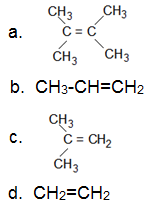Organic Chemistry – Basic Principles, Classification, IUPAC Nomenclature, Purifications, Technique and Characterisation of Organic Compounds
India Study Solution Test Series (Practice
Questions)
NEET, JEE Mains, JEE Advanced, MCAT Preparation
Hi Guys,
Welcome back to your own site India Study Solution
India
Study Solution NEET, JEE preparation MCQ test series Set 4: In each set we
provide a set of 10 most important and expected basic with some advanced level
questions to facilitate online preparation of NEET, JEE, MBBS Admission Tests,
Engineering Entrance Exams and also many other competitive exams.
Here
are Question No. 31-40 with their hints & solutions from our Chemistry Solutions on chapter “Organic
Chemistry – Basic Principles, Classification, Nomenclature, Purification and
Characterisation of Organic Compounds”.
Link to NEET and
JEE syllabus for this chapter

Friends, believe me ... if you are preparing
for any medical (MBBS) or engineering (B.Tech) entrance exam and have still not
attempted our previous questions or other sections of Chemistry,
Biology,
Physics
then you are really missing something very important.
You can find links for these from the
menu above and go through them!
If you have not subscribed us yet then you can subscribe this site before you forget ((button is given; it is free), like and follow us in Facebook, Twitter which will keep you updated whenever we publish more questions or even with the latest EduNews related to JEE, NEET, NTA, MCAT etc.
Ok, let us begin ...
Introduction to Organic Chemistry
India Study Solution Test Series – Set 4 (Q. No 31-40)
Question 31: The best method for the separation of naphthalene and benzoic acid from their mixture is
a.
Sublimation
b. Filtration
c. Distillation
d. All of
these
Question 32: An
organic compound contains about 52% carbon. It could be:
a. ethanol
b. dimethyle
c. acetic
acid
d. phenol
Question 33: The
number of structural isomers in C4H10O will be
a. 7
b. 8
c. 5
d. 6
Question 34: A
compound containing only carbon, hydrogen and oxygen, has a molecular weight of
44. On complete oxidation it is converted into a compound of molecular weight
60. The original compound is:
a. an
aldehyde
b. an acid
c. an alcohol
d. an ether
Question 35: The
least reactive alkene towards dil. HCl is

Question 36: Kjeldahl’s
method cannot be used for estimation of nitrogen in:
a. pyridine
b. azobenzene
c. nitrobenzene
d. all of
these
Question 37: Which
of the following chemical system is non aromatic?

Question 38: An organic compound contains carbon, hydrogen and oxygen. Its elemental analysis gave C, 38.71% and H, 9.67%. The empirical formula of the compound would be:
a. CH2O
b. CH4O
c. CH3O
d. CHO
Question 39: In
steam distillation of toluene, the pressure of toluene in vapour is
a. Equal to
pressure of barometer
b. Less than
pressure of barometer
c. Equal to
vapour pressure of toluene in simple distillation
d. More than
vapour pressure of toluene in simple distillation
Question 40: Alicyclic
compounds are:
a. aromatic
compounds
b. aliphatic
cyclic compounds
c. heterocyclic
compounds
d. none of the above
<><><><><>
India Study Solution - Hints and Solutions Chemistry MCQ Test Series
Organic Chemistry
(Basic Principles, Classification, IUPAC Nomenclature,
Isomerism, Purification and Characterisation of Organic Compounds)
Hints and Solutions of
Organic Chemistry Test Series (MCQ) – Set 4 (Q. No.31–40)
https://www.indiastudysolution.com
Answer 31: b. Answer 32: a,
b. Answer 33: a. Answer 34: a. Answer 35: d. Answer
36: d. Answer 37: a. Answer 38: c. Answer 39: b. Answer
40: b.













